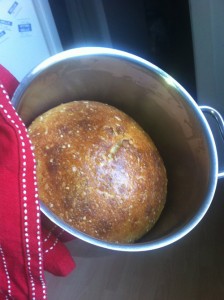In 1976 Paul MacCready won 100,000$ for the first human-powered flight. Many before him had tried and failed. MacCready succeeded by re-phrasing the problem from “build a human-powered aircraft” into “create a process that allows to build, test and change a human-powered aircraft in a single day (instead of building for months before you can test)”
Sounds familiar? I spy variations of agile tenets in there, such as “Fail early, fail often”, “short feedback cycle”, “If it’s painful, do it more often (and it’ll get easier)”, and “Iterate!”
I found my own version of “speed up the process” in the – slightly much less exciting – domain of food. See, to me cooking is incredibly boring. I like to eat (a lot!) but not to cook.
 Then I read this light-hearted book about Anke Gröner’s journey to deliberate cooking and eating. She mentions a dead simple recipe for bread. I’ve never considered making my own bread before, at least not without a bread machine. So I was very surprised at how simple it can be. All it takes are 10 minutes conscious effort and 21 hours waiting time. Genius!
Then I read this light-hearted book about Anke Gröner’s journey to deliberate cooking and eating. She mentions a dead simple recipe for bread. I’ve never considered making my own bread before, at least not without a bread machine. So I was very surprised at how simple it can be. All it takes are 10 minutes conscious effort and 21 hours waiting time. Genius!
10 minutes is such little effort that I’m willing to invest and invest it often, always trying new ingredients. Because, if a mixture turns out untasty, I’ve wasted 10 minutes and some flour. That makes it worth it to me to test out new combinations. In agile terms, it’s safe to fail.
Recipe for yummy No-Knead-Bread
Apparently this recipe has been in every cooking blog ever but if you don’t happen to read these and would still like to try, here’s the recipe for No-Knead-Bread aka Topfbrot (pot bread):
In a bowl mix
- 400 gr of flour (original recipe says 550 wheat flour, I prefer 1050)
- 1 1/2 tea spoons of salt
- 1/2 tea spoon of dry yeast
- Any kind of seed you like e.g. 50 gr of sesame or a handful of sun flower seeds
While stirring slowly add
- 320 ml of water
Stir until there is no more dry flour. Add a little more water if absolutely necessary.
Cover the bowl with a lid or wrapping film. (I’ve used a kitchen towel once but the top of the dough dried …) Leave the bowl alone for 20 hours so that the dough can raise. The original recipe says to leave the bowl in a warm spot. I just leave it on the kitchen counter. Seems to work just as well. (Warmth makes the yeast more active = fluffier bread, unless you heat it to over 50 °C => kills yeast.)
After the 20 hours, set your oven to 240 °C. Put flour on a clean surface (I use a baking tray) and slam the dough on it. Fold over and slam again. Repeat 2-4 times.
Select a pot and lid that will withstand 240 °C and oil the pot’s bottom and lower walls. I use sun flower seed oil. In the beginning I didn’t know the oil trick and had to chisel my bread out of its steel prison.
I use a pot that’s 19 cm in diameter. That’s a little too small for the above amount. Once I downsized the above recipe to 3/4, I get a nice crust all around without weird spongy lower parts.
But I’m getting ahead of myself: Put the dough in the pot. Put the lid on top. Put the pot in the oven. Set your timer to 30 minutes. After 30 minutes take the lid off the pot. Set your timer to 20 minutes. Take out a fantastic smelling bread.
Enjoy it with salted butter while it’s still warm 🙂
Reduce cycle time – or not
Some might argue that 21h is still a long cycle time. That’s why a friend taught me his way of baking bread. It only takes 2h in total but the time I have to work is about 30 minutes, most of it kneading dough. Was the result tasty? Yes. Tastier than the simple one? Not really. Would I regularly bake bread the 2h way and try out different stuff? Nope, because “short conscious time” is more important to me than “short overall time”.
Will I regularly bake the simple bread? Hell yeah! And endless variations, too 🙂
